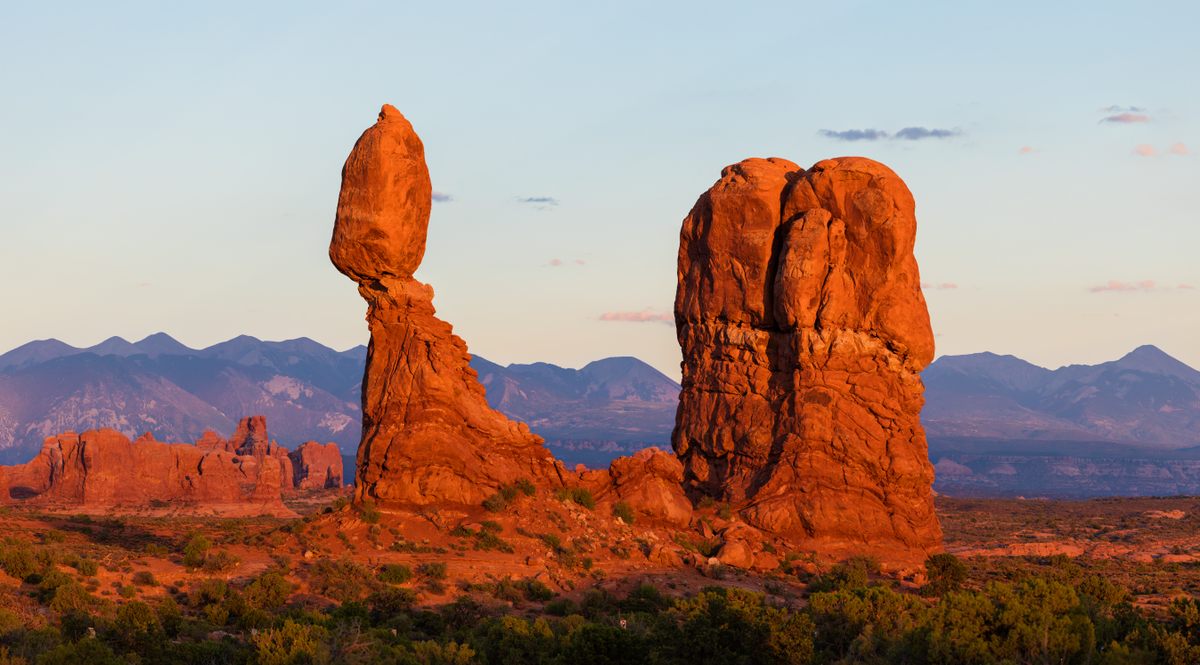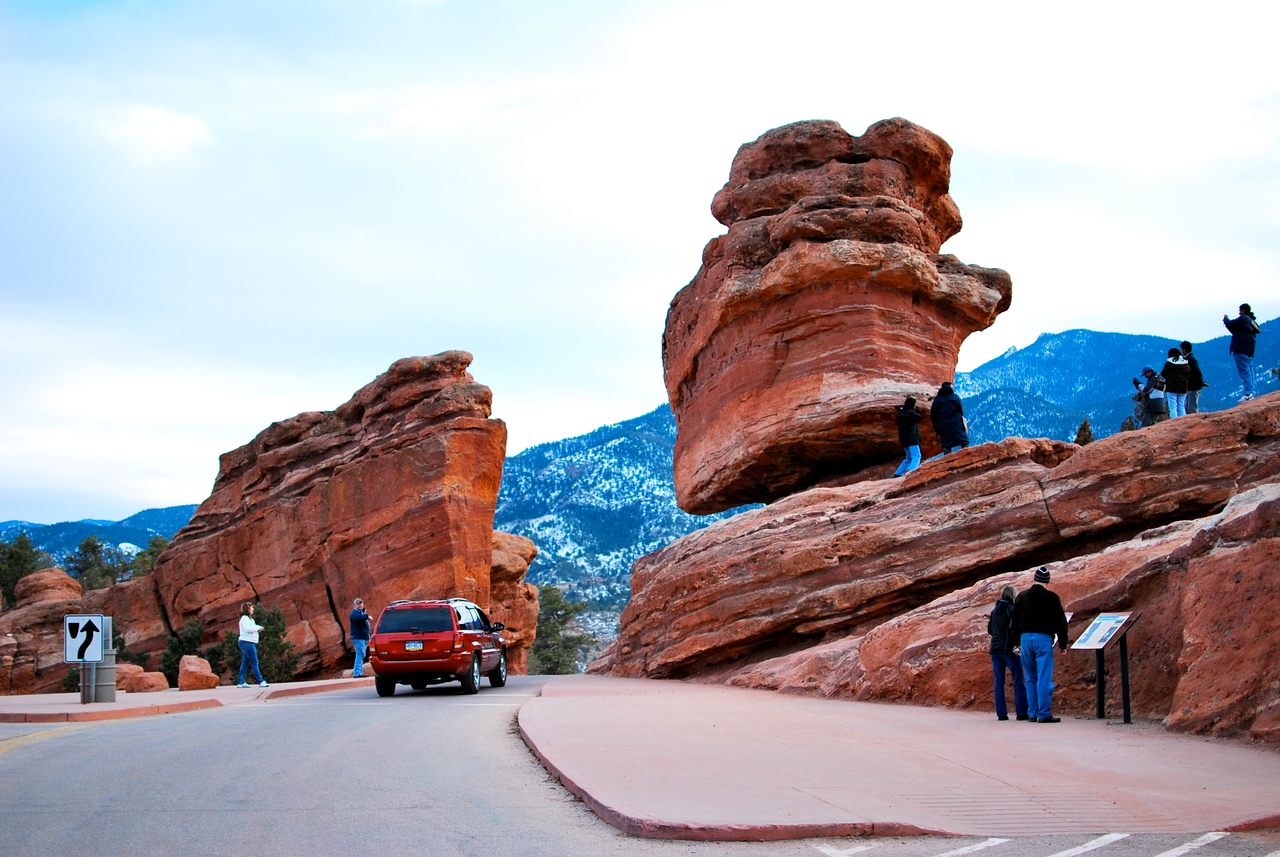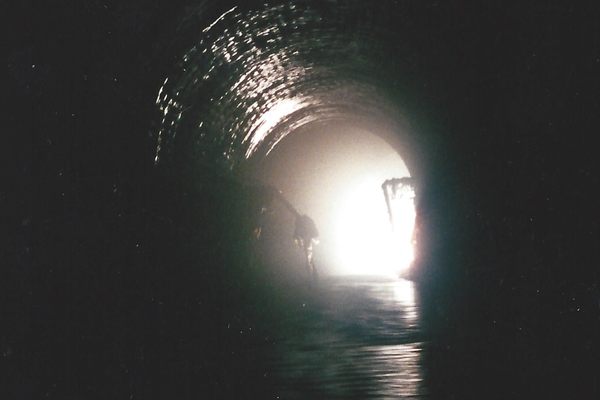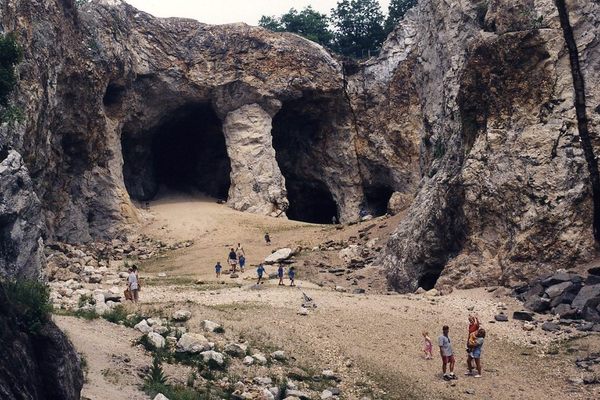Why Scientists Fall for Precariously Balanced Rocks
“They’re nature’s hilarious accidents.”
On April 1, 1994, Paul Butcher, then the director of Colorado Springs parks department, received a chilling phone call from a frantic staff member. She told him that Balanced Rock—a 290-million-year-old red sandstone boulder naturally perched on a sloped ledge in Garden of the Gods Park—had fallen. Butcher panicked, his thoughts roiling with how disappointed and outraged both locals and visitors would be with the loss of the beloved, iconic landmark. He imagined the 700-ton boulder rolling downhill, with nothing to stop its tumble onto the nearby U.S. Highway 24, like a monstrously dense tumbleweed. Then he remembered the calendar, and realized it was a prank. “I never laughed,” Butcher, who is now retired, told Out There Colorado. “It’s not a great joke.”
In a way, the mere existence of Balanced Rock also seems like a prank, either geological or cosmic. The enormous boulder looks like it had been photoshopped onto the landscape, or photographed mid-roll, or carefully placed by aliens. But it’s no hoax and there’s no sorcery to it. Rather it is a prime example of a whole category of geologic formations called “precariously balanced rocks”—PBRs, for short. They’re exactly what you might expect. “It’s a rock balanced on top of another rock,” says Mark Stirling, who studies PBRs at the University of Otago in New Zealand. And if you think Colorado Springs’ landmark ought to have a more imaginative name, see also: Balanced Rock in Grand Junction, Balanced Rock in Rocky Mountain National Park, and Balanced Rock at the Rampart Range. And that’s just Colorado.
PBRs are more than just unusual geologic features—they’re a source of valuable scientific insight. They’re what are called “reverse seismometers” because their mere existence makes it possible to measure earthquakes that didn’t happen. If they’re still balanced, then the earth hasn’t moved enough to knock them over, at least in the last few thousand years, according to geologists David E. Haddad and J. Ramón Arrowsmith in their seminal 2011 report Geologic and Geomorphic Characterization of Precariously Balanced Rocks. So scientists study them to understand a region’s seismic history and, subsequently, predict what might come in the future. “They’re nature’s hilarious accidents,” says Amir Allam, a geologist at the University of Utah.

PBRs are a subset of a larger category called “fragile geologic features,” Stirling says. This includes any kind of rock that doesn’t meet the precise standard of a detached boulder balancing on another boulder, such as hoodoos (a mushrooming rock attached to a tall spire pedestal) and glacial erratics (boulders transported by ancient glaciers to new resting places), which are also considered PBRs when they land on another, curved rock—or a few of them, like in the case of Balanced Rock in New York’s Hudson Valley. Fragile geologic features also include other landforms, such as the Punta Ventana arch in Puerto Rico that recently collapsed as a result of a series of earthquakes. Though they don’t fit neatly into PBR researchers’ equations, they can be used in the same way to assess past and future earthquakes, Stirling says.
PBRs often start their journeys deep underground. Large chunks of rock develop spidery fractures, expanded by percolating water, until they become multiple smaller chunks, Allam says. As erosion lowers the ground level, over many thousands of years, the rocks come to the surface, often stacked atop each other. “You need the right kind of climate conditions to create PBRs, and you need the right climate to make them last,” he says. “The American West is the perfect storm for this.”
The whole PBR-science idea started in the 1990s with James Brune, a geologist at the California Institute of Technology. “Brune was an old school genius,” Allam says. “He wore suspenders to all his presentations and wrote all his notes by hand.” Brune was assessing earthquake risk in Yucca Mountain, Nevada, to evaluate its future as a possible nuclear-waste storage site, when he noticed a handful of boulders balanced—rather precariously—on other stones, according to American Scientist. The boulders were all coated with desert varnish—a dark sheathe of clay, manganese, and iron oxides—indicating they had been exposed for millions of years. Brune realized the rocks offered a kind of record of the area’s seismic history, or lack thereof. So, by running PBRs through computer models that replicate earthquakes, Brune figured he could determine what level and type of shaking it would take to topple a particular rock, and then therefore rule that shaking out of its recent history.

When Brune first introduced this idea, it ruffled more than a few feathers. “Twenty-five years ago, the whole topic of PBRs was a fringe area of seismology,” Stirling says. “We were too edgy, too out of the mainstream.” Back then, he says, seismologists studied earthquakes, paleoseismologists studied prehistoric earthquakes, and engineering seismologists studied ground motion. Brune’s approach to PBRs straddled all these fields, and that kind of triple-dipping in science often leads to skepticism, Stirling says. Other early PBR enthusiasts also struggled to get funding and resources for their work. But a good idea is a good idea and they persisted, Stirling says, with Brune leading the charge. By the early 2010s, PBR science had respect within the field and funding from sources such as PG&E and other energy companies, who wanted to understand the earthquake risk for their plants.
Allam studies Utah’s seismic history, and colleagues even call him “the PBR guy.” His chaotic website includes a tab for them—“PBR!”—and a quote from Japanese writer Haruki Murakami that carries extra meaning for seismologists: “My biggest fault is that the faults I was born with grow bigger each year.” Allam is particularly enamored with shaking boulders enough to knock them over—only not in real life. “It’s also because they’re really cool,” he admits.

Allam has made it his mission to map every PBR—and the forces required to topple them—in Utah. He’s compiled at least 40 so far, but the trickiest thing about studying PBRs remains finding them in the first place. Allam has a whole team of undergrads who are, rather understandably, also pretty into PBRs. “I tell them to go on Google Earth, look for rocky outcrops, and then go drive out and check it out,” he says. He also goes hiking with his students, to show them PBRs he’s already identified and rely on their fresh eyes to spot more.
Once he finds a new PBR, Allam covers it with strips of tape to prepare it for photogrammetry, in which he merges photographs of the rock to construct a 3-D digital counterpart. To assess how long the rock has been precarious, Allam measures the concentrations of cosmogenic radionuclides on the underside of the rock, which offer a history of how long a rock has been exposed. The PBRs he studies tend to be approximately 30,000 years old. “Big earthquakes happen every 150 to 1,000 years, so 30,000 years is a statistically reliable data point,” he says.
Once Allam has the model, he shakes it in a computerized earthquake simulation. He starts off small, with a peak horizontal ground acceleration of 0.2 g (that is, g-forces, or the acceleration due to gravity). If that doesn’t do it, he goes to 0.25 g, and then maybe a little bit more until it comes tumbling down. No one wants to be in the way of a real falling rock, but he’s not after a rock’s threat level. “PBRs rarely fall and hurt people,” Allam says, because most are so remote. “The earthquake itself is much more dangerous.”

The geology of Utah makes it a great place for PBRs, but they can be found throughout the world. In Lacrouzette, France, an oak and chestnut forest cloaks a large rock that bears a famously uncanny resemblance to a goose. Mount Desert, Maine, has Bubble Rock; Mahabalipuram, India, has Krishna’s Butter Ball; and Ruokolahti, Finland, has Kummakivi. In Myanmar’s Thaton District, Kyaiktiyo, a 25-foot-tall boulder perched on the edge of a cliff wears a small pagoda like a hat. (Rocky towers along the Hudson River between New Jersey and New York are actually manmade, by artist Uliks Gryka.)
Allam’s shaking has to take place inside a lab because there is one cardinal rule of researching—or even just visiting—PBRs: Do not knock them over. All PBRs will eventually fall down, their bases worn down by erosion, their weight distribution changed by time, and the occasional earthquake, large or small. The chance of this happening to any particular PBR in a human lifetime is almost zilch, Allam says, but there is one other way that PBRs can come down.
Take 2012, when a scandal rocked the Utah Boy Scouts. Glenn Taylor, a scout leader, was filmed pushing over a hoodoo (what locals call a goblin) in Goblin Valley State Park, by a friend, David Hall. In the video, Taylor wedged himself against the boulder and heaved his weight into it. Nothing happened at first, but then the rock thudded to the ground, and Taylor high-fived his large adult son.
“It was an appalling act of vandalism,” Stirling says. Taylor and Hall were sentenced to a year of probation, after pleading guilty to criminal mischief, according to the Salt Lake Tribune.

This specter does loom over some PBRs. All it takes is a moment. “Some of the huge ones could be easily dislodged with a couple of guys and a crowbar,” Allam says. “Something the size of a watermelon, well, you could push over yourself.” Once, during one of his PBR surveys, Allam spoke with a shepherding family who say knocking over precarious rocks is a family tradition that runs back generations. “They said, ‘Our favorite thing is to roll boulders down a mountain,” he says. “Which makes sense, if you’re bored and surrounded by nothing but sheep.”
Felled PBRs—dropped by causes natural or unnatural, can be almost indistinguishable from ordinary boulders, unless you know what you’re looking for. If you see some smaller boulders scattered around an area with still-balanced PBRs, there’s a good chance you’re looking at their former neighbors, perhaps grounded by human hands. In the future, Stirling says, he hopes that fragile rock formations will be treated with the same reverence as archaeological sites.
“Once it’s toppled,” Allam says, “there’s no getting back to the past.”
You can join the conversation about this and other stories in the Atlas Obscura Community Forums.





























Follow us on Twitter to get the latest on the world's hidden wonders.
Like us on Facebook to get the latest on the world's hidden wonders.
Follow us on Twitter Like us on Facebook